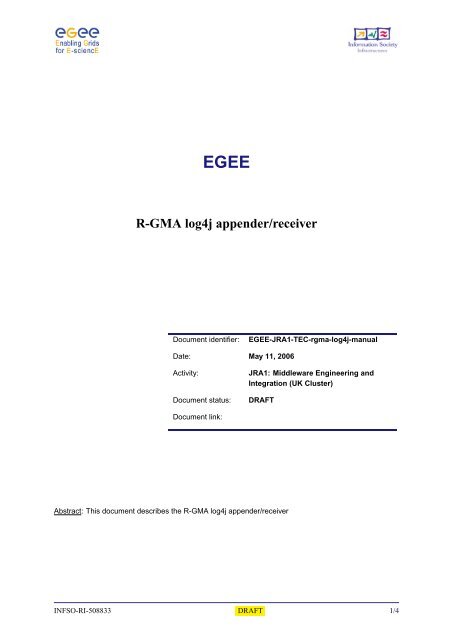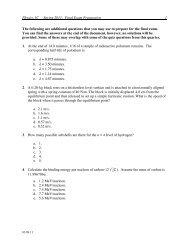You also want an ePaper? Increase the reach of your titles
YUMPU automatically turns print PDFs into web optimized ePapers that Google loves.
<strong>EGEE</strong><br />
R-<strong>GMA</strong> <strong>log4j</strong> <strong>appender</strong>/<strong>receiver</strong><br />
Document identifier:<br />
<strong>EGEE</strong>-JRA1-TEC-rgma-<strong>log4j</strong>-manual<br />
Date: May 11, 2006<br />
Activity:<br />
Document status:<br />
JRA1: Middleware Engineering and<br />
Integration (UK Cluster)<br />
DRAFT<br />
Document link:<br />
Abstract: This document describes the R-<strong>GMA</strong> <strong>log4j</strong> <strong>appender</strong>/<strong>receiver</strong><br />
INFSO-RI-508833 DRAFT 1/4
R-<strong>GMA</strong> LOG4J APPENDER/RECEIVER<br />
Doc. Identifier:<br />
<strong>EGEE</strong>-JRA1-TEC-rgma-<strong>log4j</strong>-manual<br />
Date: May 11, 2006<br />
1 INTRODUCTION<br />
The <strong>log4j</strong> framework allows you to instrument your Java application with logging calls. Normally, the<br />
user defines a properties file that defines the verbosity level of logging and where logging information<br />
will be placed. The user may route logging output to stdout, to file or to a socket. In <strong>log4j</strong> nomenclature,<br />
these are referred to as ’<strong>appender</strong>s’.<br />
The R-<strong>GMA</strong> <strong>log4j</strong> <strong>appender</strong> allows you to to publish the logging events into R-<strong>GMA</strong> instead of the<br />
standard <strong>log4j</strong> <strong>appender</strong>. This utility is built on top of the <strong>log4j</strong> framework by providing a customized<br />
<strong>appender</strong> that slots into R-<strong>GMA</strong>.<br />
A <strong>receiver</strong> utility is also available to read-in information published using R-<strong>GMA</strong>. By using the <strong>receiver</strong><br />
utility, the user can then monitor the progress of his/her application over the ’grid’.<br />
2 GETTING STARTED<br />
We assume users are familiar with <strong>log4j</strong>, if not, please take the time to skim through the online docs<br />
available on http://logging.apache.org/<strong>log4j</strong>/<br />
3 PUBLISHING LOGGING EVENTS<br />
Edit your <strong>log4j</strong>.properties file to use the R-<strong>GMA</strong> Appender as follows:<br />
#<br />
# Set root logger priority to WARN and its only <strong>appender</strong> to A1.<br />
#<br />
<strong>log4j</strong>.rootLogger=DEBUG, A1<br />
#<br />
# This is the R-<strong>GMA</strong> Appender to use<br />
#<br />
<strong>log4j</strong>.<strong>appender</strong>.A1=org.glite.rgma.<strong>log4j</strong>.Appender<br />
#<br />
# Set the name of the application you want to run here<br />
#<br />
<strong>log4j</strong>.<strong>appender</strong>.A1.JobName=ExampleJob<br />
#<br />
# A1 uses PatternLayout, and displays date/time with each log.<br />
#<br />
<strong>log4j</strong>.<strong>appender</strong>.A1.layout=org.apache.<strong>log4j</strong>.PatternLayout<br />
<strong>log4j</strong>.<strong>appender</strong>.A1.layout.ConversionPattern=%d [%t] %-5p %c - %m%n<br />
#<br />
# Setup the logging level for each of your classes here<br />
# as normal.<br />
#<br />
<strong>log4j</strong>.logger.org.glite.rgma.<strong>log4j</strong>.<strong>appender</strong>.Example=DEBUG<br />
INFSO-RI-508833 DRAFT 2/4
R-<strong>GMA</strong> LOG4J APPENDER/RECEIVER<br />
Doc. Identifier:<br />
<strong>EGEE</strong>-JRA1-TEC-rgma-<strong>log4j</strong>-manual<br />
Date: May 11, 2006<br />
Set the JobName property to a value which identifies your application.<br />
Then add the glite-rgma-<strong>log4j</strong>.jar file to your classpath (located under $R<strong>GMA</strong>_HOME/share/java)<br />
and add the <strong>log4j</strong>.properties file as a property to the JVM, eg:<br />
java -cp $CLASSPATH -D<strong>log4j</strong>.configuration=file:/[location of <strong>log4j</strong>.properties] myapp<br />
Where $CLASSPATH contains glite-rgma-log4.jar.<br />
When started, all <strong>log4j</strong> calls will then be published via R-<strong>GMA</strong>.<br />
This example <strong>log4j</strong>.properties file is included in the rgma-<strong>log4j</strong> distribution as:<br />
$R<strong>GMA</strong>_HOME/share/rgma-<strong>log4j</strong>/example-<strong>log4j</strong>.properties<br />
4 RECEIVING LOGGING EVENTS<br />
The $R<strong>GMA</strong>_HOME/bin/rgma-log-<strong>receiver</strong> script is used to retrieve published logging events. This<br />
script takes the following parameters:<br />
--format=<br />
--help<br />
--jobname=<br />
The \verb --format option defines how the retrived logging events are printed to stdout.<br />
The options you can use are list as follows:<br />
\begin{verbatim}<br />
%d: the time stamp of the event (in UTC)<br />
%t: the thread executing the logging event<br />
%p: the logging level<br />
%c: the class name generating the logging event<br />
%m: the log message<br />
%n: defines a new line<br />
4.1 FORMAT EXAMPLES<br />
--format="[%t] %d %p %c - %m%n"<br />
[main] 2004-10-27 09:23:58,977 DEBUG org.glite.rgma.<strong>log4j</strong>.Example - message<br />
--format="[%d] [%t] - %m%n"<br />
[2004-10-27 09:23:58,977] [main] - message<br />
--format="%d [%t] %-3p %c - %m%n"<br />
2004-10-27 09:23:58,977 [main] DEBUG org.glite.rgma.<strong>log4j</strong>.Example - message<br />
The last example represents the default format if none is defined. Note the ’%-3p’ pre-appends 3 white<br />
spaces before the substituted property. You can modify this to be any value for any substitution eg<br />
’%-5d’ will add 5 white spaces before the date/time stamp.<br />
INFSO-RI-508833 DRAFT 3/4
R-<strong>GMA</strong> LOG4J APPENDER/RECEIVER<br />
Doc. Identifier:<br />
<strong>EGEE</strong>-JRA1-TEC-rgma-<strong>log4j</strong>-manual<br />
Date: May 11, 2006<br />
The --jobname option must match the same jobname that you defined in your log4.properties (when<br />
you published your logging data). This ensures the <strong>receiver</strong> will read-in only the relavant data applicable<br />
to your application.<br />
Some examples of usage are shown when running the --help option.<br />
INFSO-RI-508833 DRAFT 4/4



